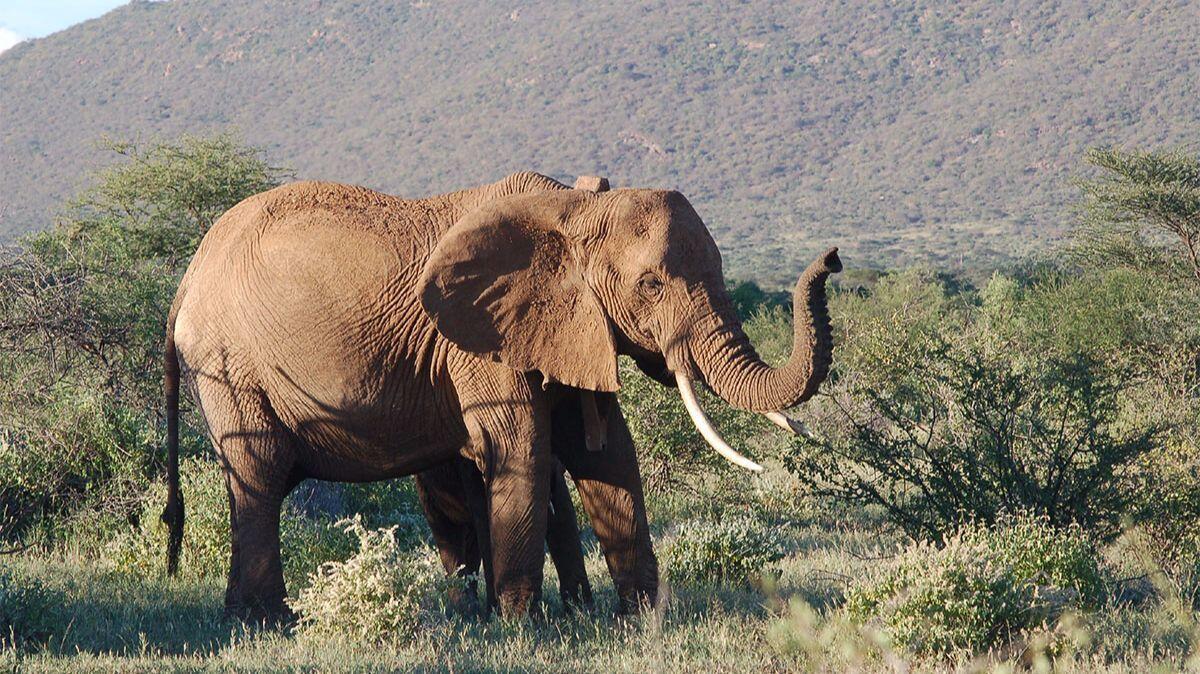Elephant poachers are hard at work in Africa, and carbon dating proves it

- Share via
Elephant poaching is alive and well — and the elephants are not. A team of scientists examining seized shipments of elephant ivory from Africa have found that the vast majority came from elephants that died within the last three years.
The sobering results, published this week in the Proceedings of the National Academy of Sciences, reveal that the killing of elephants for their ivory is continuing at a disturbing pace — even as elephant populations across the continent are in sharp decline.
While poaching had been easing for several years, it has returned with a vengeance in the last decade or so, said study lead author Thure E. Cerling, a geochemist at the University of Utah in Salt Lake City.
Central African forest elephants have fallen by an estimated 62% from 2002 to 2011. At the Selous Wildlife Reserve in Tanzania, savanna elephants have declined 66% from 2009 to 2013.
“There’s been a staggering rate of elephant loss every year,” Cerling said.
Last year, in a study led by Samuel Wasser of the University of Washington, scientists analyzed the DNA locked in 28 large seizures of ivory (at least half a ton each) made between 1996 and 2004. They matched the ivory to 1,350 DNA samples taken from dung gathered at 71 spots across 29 different countries. That allowed them to map the ivory’s sources and monitor changes in poaching patterns as elephants in one country dwindled or as political pressure to protect them ramped up.
But some skeptics suggested that the seized shipments might not contain ivory from recently killed animals. Instead, it could be old ivory “leaking” out of government stockpiles.
“Some people were saying, ‘Well, we don’t need to worry so much because there’s big stockpiles of ivory, so we’re getting legacy ivory into the market’” Cerling said. ”Other people were saying, ’No, no, no, these are all recent deaths.’”
As it happens, scientists can figure out exactly how long ago an elephant died thanks to the Cold War nuclear arms race.
The spate of nuclear testing by the U.S. and Russia in the 1950s and 1960s nearly doubled the global concentration of a certain carbon isotope, carbon-14, by 1963. That carbon-14 spike is recorded in tree rings, in the bottom of the oceans, even in our own teeth.
Because this isotope’s abundance has been declining at a well-known rate since 1963, scientists can use the carbon-14 concentration to tell when a living tissue first formed.
Cerling and his colleagues applied this dating technique to 231 samples of ivory taken from 14 large caches (also at least half a ton each) that were confiscated between 2002 and 2014. They focused on the carbon-14 in the pulp cavity inside the ivory, using a sample taken near the base that would have grown in the last two or three months before the elephant died.
The researchers discovered that some 90% of the ivory was taken from animals that died less than three years before the ivory was seized by government officials. In fact, of all the analyzed specimens, only one had a lag time longer than six years, the authors wrote.
“That means all of the ivory that’s being seized by customs is [from] very recently killed elephants,” Cerling said. “So indeed, the crisis is severe if we’re going to preserve this species on our planet.”
The new findings, coupled with the ability to genetically trace ivory’s origin, will aid efforts to track and tackle this illegal poaching, said George Wittemyer, a conservation scientist at Colorado State University who was not involved in the study.
“Because it’s illegal and because it tends to be done by pretty organized criminal syndicate groups, we just are having a lot of difficulty understanding what’s happening, where the goods are being trafficked, where they’re originating, where they’re moving, how they’re moving through the supply chain, who’s involved,” he said. ”That lack of information really makes it hard to do much effective enforcement or to disrupt this global trade.”
The findings add an important piece of information to the puzzle, he said. And ultimately, the methods used in this research could be applied to a host of other species at risk of being poached to extinction.
The study includes a small silver lining, Cerling said: “Legacy” ivory is not leaking out of sealed government stockpiles, as some had feared.
That means the focus needs to remain on current poaching, not on keeping old ivory off the market, Wittemyer said.
“It’s not something that we really want to spend a huge amount of effort monitoring,” he said. “What we really want to get to [are] these more contemporary, current killings.”
Part of the problem is that while demand for ivory in Europe and North America has dropped, markets in increasingly prosperous countries in Southeast Asia — such as China, Vietnam and the Philippines — have been growing.
”When their economy improved, it became a desirable object,” Cerling said.
Educating potential consumers in that part of the world is key, he added, as is working with courts to ensure that they mete out severe sentences for breaking national and international poaching laws.
“We’ve got a lot to do,” Cerling said. “And we’ve got to do it fast.”
Follow @aminawrite on Twitter for more science news and “like” Los Angeles Times Science & Health on Facebook.
MORE IN SCIENCE
Bonobos get far-sighted with age, just like us
Feeling anxious about the election? Here’s how to cope with election stress disorder
UPDATES:
6:20 p.m.: The story was updated with comments from George Wittemyer.
The story was originally published at 12 p.m.




